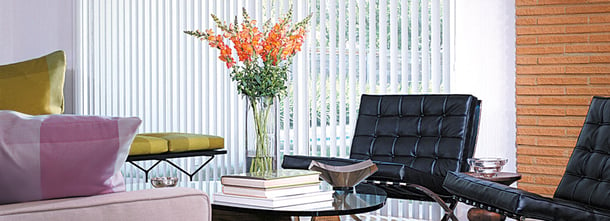 Vertical blinds and horizontal blinds are the two main types of blinds used in homes. While they are both suitable for use as window or door covering, each type has its own distinct differences and are designed for specific purposes. Before shopping for window treatments, it is a good idea to familiarize yourself with these differences and what type would be best for your application.
Vertical blinds and horizontal blinds are the two main types of blinds used in homes. While they are both suitable for use as window or door covering, each type has its own distinct differences and are designed for specific purposes. Before shopping for window treatments, it is a good idea to familiarize yourself with these differences and what type would be best for your application.
Let’s Start with the Obvious
Horizontal blinds have slats that hang in a horizontal fashion. The slats are traditionally 1 to 2 inches in width. Vertical blinds hang vertically from a head rail that usually is mounted to a track. Their slats are usually much wider than the slats found with horizontal blinds. A wand or pulley system is used to open and close vertical blinds. There are some similarities between the two types of blinds, including:
- Both horizontal and vertical blinds are designed to control light and provide privacy.
- Both types are ideal for rooms where privacy and light control are desired, such as baby nurseries, bedrooms, or bathrooms.
- Horizontal and vertical blinds are constructed from lightweight materials, which makes for easy installation.
Where Would You Use Each Type?
The most commonly used blind is the horizontal blind. This type of blind is generally used for small or medium-sized windows. When considering horizontal blinds, here are some of the benefits associated with this type:
- They are great for tall and narrow windows because of their construction.
- They make much less noise than vertical blinds because they have no tracks, which also means no greasing tracks either.
- They last longer and require less maintenance than vertical blinds because there are fewer moving parts that can wear out or require maintenance.
- They provide more privacy than vertical blinds that tend to sway or go off-kilter, which causes gaps that can allow someone to peer through into your home.
Meanwhile, vertical blinds are designed more for use with sliding glass doors or large windows where horizontal blinds might not be practical.
- Vertical blinds are easy to open and close. They are ideal for wide windows and doors.
- While some may be made with fabrics, most vertical blinds are usually made from moisture-resistant faux wood or PVC.
- Common household cleaning products can be used without fear of staining or fading the color of horizontal blinds.
- The larger and wider slats block more light than a horizontal blind.
Need help deciding whether you should purchase horizontal or vertical blinds for your home? Speak to one of the window treatment experts at All About Blinds & Shutters.



